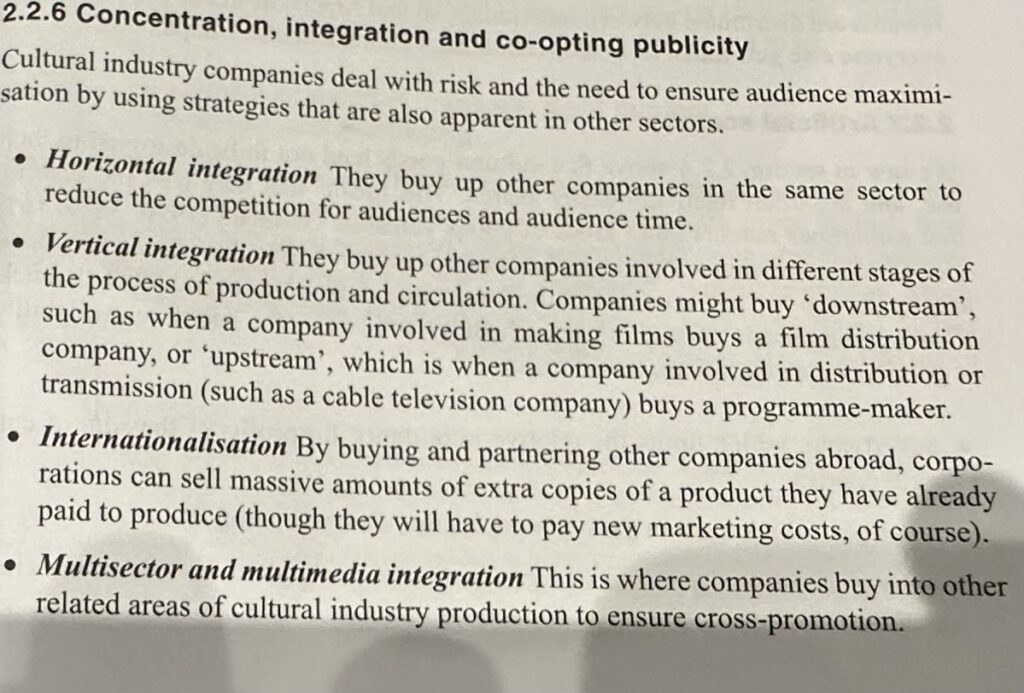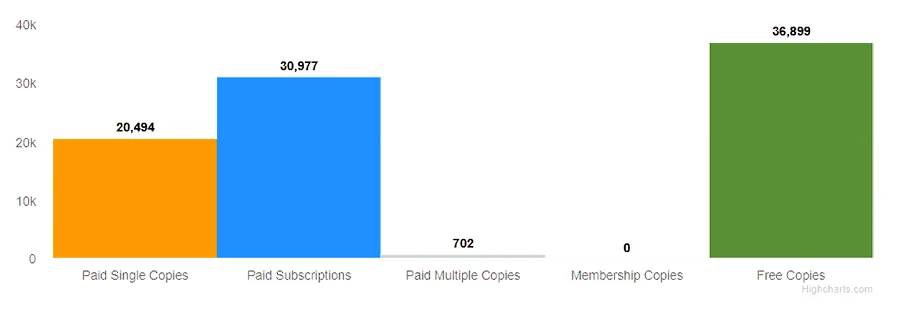Industry
Let’s recap some basic theoretical points:
James Curran and Jean Seaton, but also David Hesmondhalgh emphasized the concentration of ownership in the media industry and specifically in press.
This concentration takes the following forms.

Hesmondandhalgh has also noted that one ways of reducing risk and maximising profit is the use of ‘star power’ (formatting
All the above theorists have mentioned that print media rely increasingly on advertising avenue (rather than simply copies)
Finally, Curran, Seaton and Hesmondhalgh argued that print media had to adapt to the new digital environments, by creating online sites, engaging with new converging platforms, (social media), diversifying their services and seeking new forms of advertisement. For example they use native advertisement: Editorial content is designed to promote product. The magazine reviews products or creates texts and images and takes commission when the product is digitally purchased.
Task: explain in what ways your Close Study Product magazines confirm or/and challenge the views of Curran/Seaton and Hesmondhalgh.
To answer your question have a look at the online sites of the magazines, including their social media platforms, read their respective media kits of GQ and The Gentlewoman and then read below a summary of their entrepreneurial strategies
GQ and the Magazine Industry
GQ is published by Condé Nast – a mass media company with a global reach. Founded in 1909, they now own some of “the world’s most iconic brands”, including Glamour, Vanity Fair, The New Yorker, and Vogue.
Question how is this form of integration called?
You can read our analysis of Teen Vogue to explore how they target a younger demographic with their digital output.
Condé Nast aims to “entertain, surprise, and empower”. Of course, David Hesmondhalgh (2018) emphasises companies in the cultural industries are driven by profit. Magazines are expensive to produce so mergers are inevitable as the publishers continue to lower their costs and maximise revenue.
In fact, Condé Nast had already been acquired by Advance Publications in 1959 before they took control of GQ in 1979. After a century of investment and acquisitions, Advance’s portfolio also includes shares in Reddit and the media conglomerate Warner Bros. Discovery.

Curran and Seaton (2013) noted this concentration of power in news and information markets has always been a feature of the industry. They are concerned this pattern of ownership enables a few wealthy individuals and families, such as the Newhouse family, to distort the media landscape with their incredible political and economic influence. Another good example of a powerful media family are the Harmsworths who control DMGT and publish The Daily Mail.
However, some critics argue the media moguls do not stifle creativity because they can spread the financial risk and enable producers to develop texts which will satisfy different audiences. This is particularly important with the increasingly intense competition for advertising revenue as more and more consumers get their news and information from online sources.
According to the Audit Bureau of Circulations, the average circulation per issue in the UK was 89,072 in 2021 – down from 110,063 in 2018. Without the efficiencies which come from the larger publishing group, GQ might struggle to reach the shelves in your local retailer.

How Does GQ Make Money?
As you can see from the circulation analysis, GQ generates some revenue through single-copy sales and subscriptions. However, the publishers make the magazine available for free because they rely heavily on advertising for revenue, selling space to a wide range of companies eager to target a large and engaged readership.
If you want to raise awareness of your fashion label or grooming brand, an advertisement on the back cover of the magazine costs over £24,000. A double page spread will set you back around £40,000.
GQ’s website also has plenty of room for Google Ads. Scroll down a page about motoring and you will probably see ads for cars loading between the paragraphs and in the sidebar. However, if a company wants to work directly with the magazine, a billboard digital ad costs over £44 CPM (cost per mille). This is the amount the advertising agency pays GQ per one thousand visitors who see the advertisement.
Another important revenue stream is affiliate marketing. The editors select lots of products to review. When you click the retail link and buy something, such as a new pair of shoes or an electric shaver, the magazine will earn a commission.
Finally, GQ also collaborates with retailers and manufacturers to create advertising features which are designed and presented in the magazine’s house style. This advertorial for an anti-ageing product is a good example of this type of partnership. Native articles cost at least £20,000.
Since GQ receives some sort of payment from a brand or retailer for the advertorials, the publisher is required to identify the posts as sponsored. This regulation is overseen by the Advertising Standards Authority who applies its codes across all media to protect consumers from deceptive marketing and help us recognise what is and what isn’t advertising.
Are editorial decisions influenced by the dependence on advertising revenue to offset the costs of producing and distributing the magazine? Is the publisher really acting in the best interests of its audience? Or are the readers actually the product being sold by advertiser-supported media?
The Gentle Woman: The Magazine Industry
Despite the huge financial risks of publishing a print magazine when more and more readers are relying on digital media to learn about the world, there has been a quiet resurgence of independent titles in the UK. The Gentlewoman is produced by the owners who retain their creative control, so the content is imbued with a passion not really seen in mainstream magazines which often rely on ideas developed from extensive market research.
Rather than simply delivering commentaries and reviews on the fashion industry and inspirational women, the producers are participants in a cultural community shared by their readers. The mode of address is personal and warm.
This relationship with their audience is epitomised by The Gentlewoman Club – an international society of the magazine’s “sophisticated” and “fabulous” readers. The publishers deliver an “agenda of cultural happenings” to the “40,000 plus active members”, including walking tours, film screenings and card nights.
While other magazines aimed at this creative class of women struggled to survive, such as Oh Comely, The Gentlewoman’s innovative approach to creating an intimate connection between the editor and the reader has ensured it has remained a viable enterprise.
The Business Model
The print industry has always relied on advertising to remain profitable because the revenue from single copy sales and subscriptions is not enough to cover the costs of production and distribution of magazines and newspapers. If a brand wanted to engage their target audience of young(ish) women with money to spend on luxury fashion, they could occupy the outside back cover of The Gentlewoman for over £26,000, such as Dior and their Caravaggio inspired campaign which appeared on the back of Issue No. 23.
In fact, excluding the masthead and content pages, the Ramla Ali interview is the first piece of original material, and it begins on page 66! That is over sixty pages of advertising for the reader to enjoy

The Gentlewoman also offers digital packages to access advertising spaces on their website and they offer “creative collaborations” and “bespoke partnerships”, including previous work with brands such as Bottega Veneta and Chanel. Their newsletter contains a “classifieds section of bespoke advertisements” which is “a discerning platform for brands to reach astute consumers, direct to their inbox”.
Editorial content will never be free from commercial decisions, but the magazine makes it clear they are adding their opinion and expertise to endorse the designers, giving The Gentlewoman an authentic voice compared to the mainstream publishers. The publishers argue they are acting as curators of fashion rather than simply selling advertising space.
Exercise go through these flash cards and keep notes:
https://quizlet.com/836695978/the-gentlewoman-industries-flash-cards/

